|
 Secure Site
Secure Site
|
 |
Archive for the 'sleep' Category
 Yoshitoshi, Geisha at a Flower Festival, 1880 - Snooze More Soundly Unplug in the evening. According to a National Sleep Foundation (NSF) survey, 95 percent of people use an electronic device, such as a computer, just before bedtime. “But that can cause you to toss and turn,” says Russell Rosenberg, Ph.D., NSF chairman and director of the Atlanta School of Sleep Medicine. “The bright light from the screen delays the release of melatonin, a sleep-promoting hormone.” To snooze more soundly, switch off technology and try dimming the lights an hour before you aim to sleep.
 Snooze More Soundly Our Digital Zen Clock’s long-resonating Tibetan bell-like chime makes waking up a beautiful experience – its progressive chimes begin your day with grace. When the clock’s alarm is triggered, the acoustic chime bar is struck just once … 3-1/2 minutes later it strikes again … chime strikes become more frequent over 10 minutes … eventually striking every 5 seconds until shut off. As they become more frequent, the gentle chimes will always wake you up – your body really doesn’t need to be awakened harshly, with a Zen Clock you’re awakened more gradually and thus more naturally.
Unlike artificial recorded sounds coming out of a tiny speaker in a plastic box, natural acoustic sounds transform your bedroom or office environment.
The Digital Zen Clock also serves as a countdown and interval timer for yoga, meditation, bodywork, etc.; and it can also be set to chime on the hour as a tool for “mindfulness.”
Digital Zen Clocks feature a “high” and “low” chime strike volume control, which allows you to adjust the sound of the chime to suit your needs. The Digital Zen Clock runs on 2 AA batteries (not included) and can also be plugged in with the included AC jack. The clock includes a lighted digital display (which can be set to be lit full-time when plugged in).
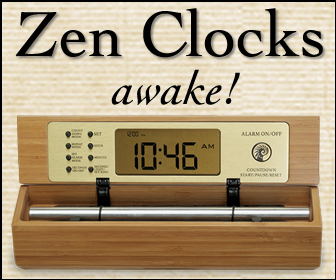 Gentle Chime Alarm Clocks for a Progressive Awakening Now & Zen’s Gentle Chime Alarm Clock Store
1638 Pearl Street
Boulder, CO 80302
(800) 779-6383
Posted in Bamboo Chime Clocks, sleep, Sleep Habits, Well-being
 Wake Up Refreshed - Try the Most Gentle Alarm Clock with Acoustic Chime Although the occasional all-nighter is OK, people who regularly skimp on z’s can’t undo sleep deprivation’s detrimental effects by simply hitting the snooze button on weekends, says a new study in the journal Science of Translation Medicine.
Contrary to popular belief, the energy you feel after a Saturday morning sleep session is only short lived, according to the study. Chronic sleep loss has a cumulative effect on performance. Why? Lack of sleep raises levels of the stress hormone cortisol and affects a person’s ability to respond to stimuli, says Catherine Darley, ND, founder of Seattle’s Institute of Naturopathic Sleep Medicine. Sleep also plays a key role in mood regulation and overall physical and mental functioning.
Waking up in the morning should be as pleasant as falling asleep at night. The Zen Alarm Clock‘s gradual, gentle awakening is transformative.
 Wake up with gradual, beautiful acoustic chimes. The Zen Alarm Clock transforms your mornings and gets you started right, with a progressive awakening
Boulder, Colorado—an innovative company has taken one of life’s most unpleasant experiences (being startled awake by your alarm clock early Monday morning), and transformed it into something to actually look forward to. “The Zen Alarm Clock,” uses soothing acoustic chimes that awaken users gently and gradually, making waking up a real pleasure.
Rather than an artificial recorded sound played through a speaker, the Zen Clock features an alloy chime bar similar to a wind chime. When the clock’s alarm is triggered, its chime produces a long-resonating, beautiful acoustic tone reminiscent of a temple gong. Then, as the ring tone gradually fades away, the clock remains silent until it automatically strikes again three minutes later.
The frequency of the chime strikes gradually increase over ten-minutes, eventually striking every five seconds, so they are guaranteed to wake up even the heaviest sleeper. This gentle, ten-minute “progressive awakening” leaves users feeling less groggy, and even helps with dream recall.
 The Zen Alarm Clock transforms mornings, awakening you gradually with a series of gentle acoustic chimes Once you use a Zen Clock nothing else will do Now & Zen – The Zen Alarm Clock Headquarter Store
1638 Pearl Street
Boulder, CO 80302
(800) 779-6383
Posted in Chime Alarm Clocks, sleep, Sleep Habits, wake up alarm clock
 KOITSU -- Full Moon at Akashi Beach - Choose an Alternative to a Snooze Button Alarm Clock Kick your insomnia for good by creating a simple and restful nighttime routine.
Whether it’s yoga to reduce muscle tension, breathing to slow the heart rate, or an herbal massage to calm a racing mind, a simple routine can be the most effective and safest road to a better night’s sleep. There is growing evidence that small behavioral changes can make a big difference in getting some good shuteye. A 2006 study published in the Journal of the American Medical Association showed that participants who made modifications like reducing stimuli in the bedroom and learning relaxation techniques improved their sleep more than those who took drugs.
The first step to feeling well rested is to institute a regular bedtime. Maintaining consistency will help keep your circadian rhythms—the biological changes that happen every 24 hours—steady. Eventually, your body will naturally understand and crave sleep during these hours.
The next step is to create some space between your busy day and sleep time. “You can’t just work until 9 at night, and then stick your head on the pillow and fall asleep,” Khalsa says. So turn off the television, computer, and radio. Cut down on or eliminate evening classes and exercise that leaves you feeling amped up. When you come home, honor this transition by playing relaxing music, lighting candles, or putting on your favorite pajamas. Think of the yoga precept ofpratyahara: Withdraw your senses in order to turn inward.
Once you’ve chosen your specific nighttime ritual, repeat it every night to cue your body that it’s time for sleep. Khalsa says that after a few weeks of practice, your sleep will improve. “These things don’t work instantly, but over time you normalize arousal and sleep starts to get better.” And as opposed to suffering from side effects such as headaches, dizziness, daytime drowsiness, and long-term dependence on drugs, you’ll feel better overall, instead of worse, with your nighttime routine. “It improves individuals on a holistic level, and other problems that they might have had also might start to dissipate,” says Khalsa. Now that sounds like a side effect we can all live with.
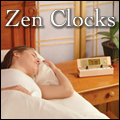 Chime Alarm Clocks for a Progressive, Peaceful Awakening Waking up in the morning should be as pleasant as falling asleep at night. The Zen Alarm Clock’s gradual, gentle awakening is transformative.
Boulder, Colorado—an innovative company has taken one of life’s most unpleasant experiences (being startled awake by your alarm clock early Monday morning), and transformed it into something to actually look forward to. “The Zen Alarm Clock,” uses soothing acoustic chimes that awaken users gently and gradually, making waking up a real pleasure. Rather than an artificial recorded sound played through a speaker, the Zen Clock features an alloy chime bar similar to a wind chime. When the clock’s alarm is triggered, its chime produces a long-resonating, beautiful acoustic tone reminiscent of a temple gong. Then, as the ring tone gradually fades away, the clock remains silent until it automatically strikes again three minutes later. The frequency of the chime strikes gradually increase over ten-minutes, eventually striking every five seconds, so they are guaranteed to wake up even the heaviest sleeper. This gentle, ten-minute “progressive awakening” leaves users feeling less groggy, and even helps with dream recall.
adapted from Yoga Journal by Nora Isaacs
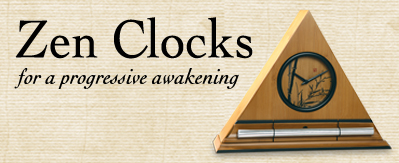 Zen Clocks for a Progressive Awakening Now & Zen’s Chime Alarm Clock Store
1638 Pearl Street
Boulder, CO 80302
(800) 779-6383
Posted in Bamboo Chime Clocks, Natural Awakening, sleep, Sleep Habits
 Why Do Some People Need More Sleep? New research suggests it is in our genes…
Some people are genetically programmed to need less sleep than the rest of us, according to a new paper published this week in Science. A rare genetic mutation lets its carriers function happily and healthily even with hours less sleep each night than doctors normally recommend.
Researchers discovered the enviable gene variant after studying a family in which two members, a mother and a daughter, seemed to need much less daily rest than their close relatives. The women slept just 6.25 hours per night, while others in the family averaged 8.06 hours. The researchers then sequenced some genes they thought could be responsible, and discovered that both mom and daughter — unlike others in the family — had a never-before-seen mutation in a gene that’s known to affect circadian rhythms.
Next, to test whether that gene variant was really the cause of mom and daughter’s shortened sleep time (and not just some freak coincidence), the researchers genetically engineered a group of mice to express the newly found mutation. Sure enough, those mice had a typical activity period that’s more than an hour longer, on average, than that of a normal mice. The mutant mice also seemed to need less catch-up sleep than others after a period of sleep deprivation.
The new findings give a fascinating insight into why humans vary so much in how long we sleep — with a good night’s shut-eye ranging anywhere from six hours to nine, depending on whom you ask. But the result can hardly explain everything. This new-found gene variant appears in just 1 in 60 families that were studied, according to a follow-up paper that’s also published this week in Science. For genes to explain the full range of human sleep needs, then, there would have to be other genes involved too.
adapted from Time.com, by Laura Blue
Our Digital Zen Clock’s long-resonating Tibetan bell-like chime makes waking up a beautiful experience – its progressive chimes begin your day with grace. When the clock’s alarm is triggered, the acoustic chime bar is struck just once … 3-1/2 minutes later it strikes again … chime strikes become more frequent over 10 minutes … eventually striking every 5 seconds until shut off. As they become more frequent, the gentle chimes will always wake you up – your body really doesn’t need to be awakened harshly, with a Zen Clock you’re awakened more gradually and thus more naturally. Unlike artificial recorded sounds coming out of a tiny speaker in a plastic box, natural acoustic sounds transform your bedroom or office environment.
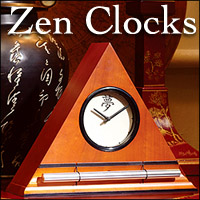 The Zen Alarm Clock transforms mornings, awakening you gradually with a series of gentle acoustic chimes Once you use a Zen Clock nothing else will do. Now & Zen – The Zen Alarm Clock Store
1638 Pearl Street
Boulder, CO 80302
(800) 779-6383
Posted in Bamboo Chime Clocks, Chime Alarm Clocks, sleep, Sleep Habits, Well-being
 Scientific Evidence for Beauty Sleep - Elegant Women. Courtesy of the Japan Ukiyo-e Museum Beauty sleep, it’s widely assumed, is one of those invented phenomena that parents use to ease their children’s passage to bedtime. After all, if sleeping had any real impact on beauty, bears, toads and frogs would be the handsomest creatures on the planet. But now a new study out of Sweden suggests there may be something to it after all.
In the study, published Tuesday on BMJ.com, John Axelsson of the Karolinska Institute looked at the effect that sleep, or its lack, had on the way other people perceived the attractiveness of the sleeper.
Axelsson’s interest in the subject was partly inspired by a question from his young daughter about whether it was the long nap that made Sleeping Beauty so lovely. And, partly, it was that he saw a gap in the scholarship. “The field of sleep research is full of studies showing the physiological and cognitive consequences of disturbed sleep,” he says, “while there is clear lack of how poor sleep affects our everyday social life.”
It’s estimated that about 40 million people suffer from chronic sleep disorders in the U.S. and a further 20 million have frequent problems sleeping. Even for good sleepers, with holiday and New Year’s celebrations oncoming, this is among the most slumber-deprived of seasons.
 How Can You Get Your Beauty Sleep? For the study, 23 participants, all between the prime partying ages of 18 to 31, were recruited. They were asked to sit for photographs in the afternoon, between 2 p.m. and 3 p.m. This time “coincides with the afternoon dip, or siesta time, a time where most people are sleepier,” says Axelsson. And unlike office workers, the study volunteers were not allowed to consume a mid-afternoon caffeinated beverage to keep them going.
Each photograph was identical — lit the same way, the same distance from the camera, with no makeup and natural hairstyles. The subjects were told to have a relaxed, neutral expression. They weren’t allowed to drink alcohol for the 48 hours prior to the experiment. The only difference among the volunteers was that some had had a full night’s sleep the night before, while others had been awake for 31 hours straight, after just five hours of sleep the previous night.
The photos were then shown to a group of 65 different people, who, knowing nothing about how tired the people in the photos were, rated their attractiveness. The observers rated the sleep-deprived as less healthy looking, less fetching and, obviously, more tired-looking.
Of course, anyone who’s ever pulled an all-nighter knows that it’s no formula for good looks — the next day, you’re saddled with puffy, bloodshot eyes, dark circles and a wan complexion — but now there’s a study to prove it. So if the old adage about getting your beauty sleep is true, what does that mean for watched pots never boiling, or crying over spilled milk? Probably nothing, but Axelsson is curious. “There are so many old ‘sayings’ or beliefs incorporated in our culture, but we do not know if they are true,” he says. “It is our scientists’ responsibility to evaluate the truth in them.”
Boulder, Colorado—an innovative company has taken one of life’s most unpleasant experiences (being startled awake by your alarm clock early Monday morning), and transformed it into something to actually look forward to. “The Zen Alarm Clock,” uses soothing acoustic chimes that awaken users gently and gradually, making waking up a real pleasure.
What makes this gentle awakening experience so exquisite is the sound of the natural acoustic chime, which has been tuned to produce the same tones as the tuning forks used by musical therapists. According to the product’s inventor, Steve McIntosh, “once you experience this way of being gradually awakened with beautiful acoustic tones, no other alarm clock will ever do.”
adapted from Time.com by Belinda Luscombe
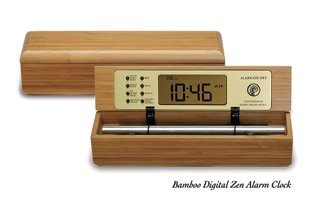 Choose a Gentle Alarm Clock to Awaken You Gently Now & Zen – The Peaceful Awakening Clock Store
1638 Pearl Street
Boulder, CO 80302
(800) 779-6383
Posted in Bamboo Chime Clocks, sleep, Sleep Habits, wake up alarm clock
 Dreams May Useful in Resetting Our Emotional Compass - Yoshitoshi Taiso Dreams may not be the secret window into the frustrated desires of the unconscious that Sigmund Freud first posited in 1899, but growing evidence suggests that dreams — and, more so, sleep — are powerfully connected to the processing of human emotions.
According to new research presented last week at the annual meeting of the Associated Professional Sleep Societies in Seattle, adequate sleep may underpin our ability to understand complex emotions properly in waking life. “Sleep essentially is resetting the magnetic north of your emotional compass,” says Matthew Walker, director of the Sleep and Neuroimaging Lab at the University of California, Berkeley.
REM sleep appears to not only improve our ability to identify positive emotions in others; it may also round out the sharp angles of our own emotional experiences. Walker suggests that one function of REM sleep — dreaming, in particular — is to allow the brain to sift through that day’s events, process any negative emotion attached to them, then strip it away from the memories. He likens the process to applying a “nocturnal soothing balm.” REM sleep, he says, “tries to ameliorate the sharp emotional chips and dents that life gives you along the way.
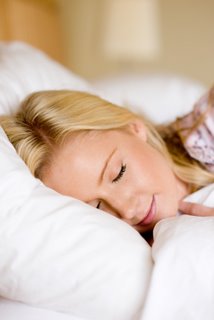 Can Dreams Improve Our Emotional Life? adapted from Time.com, by Tiffany Sharples
Boulder, Colorado—an innovative company has taken one of life’s most unpleasant experiences (being startled awake by your alarm clock early Monday morning), and transformed it into something to actually look forward to. “The Zen Alarm Clock,” uses soothing acoustic chimes that awaken users gently and gradually, making waking up a real pleasure. Rather than an artificial recorded sound played through a speaker, the Zen Clock features an alloy chime bar similar to a wind chime. When the clock’s alarm is triggered, its chime produces a long-resonating, beautiful acoustic tone reminiscent of a temple gong. Then, as the ring tone gradually fades away, the clock remains silent until it automatically strikes again three minutes later. The frequency of the chime strikes gradually increase over ten-minutes, eventually striking every five seconds, so they are guaranteed to wake up even the heaviest sleeper. This gentle, ten-minute “progressive awakening” leaves users feeling less groggy, and even helps with dream recall.
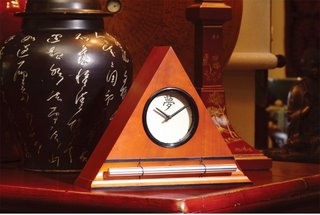 Gentle Chime Alarm Clocks for a Progressive Awakening Now & Zen – The Chime Alarm Clock Store
1638 Pearl Street
Boulder, CO 80302
(800) 779-6383
Posted in Bamboo Chime Clocks, sleep, Sleep Habits, wake up alarm clock, Well-being
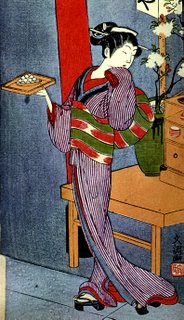 What Do Dreams Mean...Kasamori Osen Ippitsusai Buncho Recent developments in dream research won’t make sense without first touching on the academic thunderbolt of 1977, when a paper by two Harvard neurophysiologists, Allan Hobson and Robert McCarley, ran in the American Journal of Psychiatry. At the time, Sigmund Freud’s theory of dreams (which holds, in part, that dreams preserve sleep by distracting the brain with reflections of the unconscious) was a pillar of psychiatry. In The Brain as a Dream State Generator: An Activation-Synthesis Hypothesis of the Dream Process, the Harvard pair challenged Freudian theory on virtually every point. They argued that dreams are nonsense created when the forebrain makes “the best of a bad job in producing even partially coherent dream imagery from the relatively noisy signals” sent up to it from the brain stem at the onset of REM. Their paper served to yank dreaming from the realms of the psychological and plonk it in a dreary, physiological bucket.
Later, the English molecular biologist Francis Crick, a co-discoverer in the 1950s of the structure of the DNA molecule, drained a little more romance from dreaming. His and theoretical biologist Graeme Mitchison’s “reverse learning” theory held that dreams rid the brain of superfluous notions, and that without this regular flushing brain overload would manifest as hallucinations and obsessions. There are echoes of this idea in the perspective of Drew Dawson, director of the University of South Australia’s Centre for Sleep Research: “I tend to think of dreaming as a bit like backwashing the swimming pool filter.”
While hugely influential, Hobson and McCarley’s Activation-Synthesis model attracted hordes of critics, who protested that many dreams aren’t merely cognitive fragments nor a succession of chaotic images, but so story-like, sequential and dramatic that the thinking brain must surely have played a more substantial role in their production than the last-minute editing of a pile of neural bloopers. And there’s the matter of lucid dreaming, in which people become aware in the course of a dream that they are, in fact, dreaming, and are able to control the course of events—a phenomenon that strengthens the case for higher-brain involvement in dream construction. The lucid dreamer can apparently apply certain techniques to prolong the dream and take it in delightful directions. “The experiences are so convincing,” says Victoria University’s Bruck, “it seems as if another level of reality exists.”
 Dreams Serve to Process Memories But the wrecking job on the notion that dreams are a random by-product of REM sleep was carried out by the South African neuroscientist and psychoanalyst Solms, who was working at the Royal London Hospital in the 1990s when he made his career-defining discoveries. Solms wasn’t alone at the time in realizing that dreaming occurred outside periods of REM, that it was also common at sleep onset and shortly before waking in the morning. But he found an even weaker spot in the Hobson-McCarley hypothesis. If their theory was right, then people with damage to a part of the brain stem called the pons—the on-off switch for REM sleep—shouldn’t be having dreams. Solms, however, had five patients with lesions in precisely that region, and while they weren’t having REM, they were nonetheless reporting dreams.
Even more interesting to Solms were 53 Royal London Hospital patients with healthy brain stems who said they’d stopped dreaming. Most of them had damage to the part of the brain that generates spatial imagery. That made sense: if you can’t create pictures in your mind, how are you going to dream? It was the circumstances of the remaining nine patients that fascinated Solms. They had damage to the white matter of the ventromesial quadrant of the frontal lobes, an area linked to the transmission of the chemical dopamine and crucially involved in motivation, urges and cravings. These patients still experienced REM sleep but reported having lost both the capacity to dream and all sense of spontaneity, drive and love of life. They did what they were told and that was about it.
It seemed to Solms that dreams must themselves be associated with driving urges—a very Freudian take—but he needed more evidence in the form of more people with lesions in this particular spot. Nowadays, damage to that part of the brain is rare, normally a result of strokes or tumors. But it was a lot more common in the ’50s and ’60s when some mental illnesses were treated by removing it in an operation called a prefrontal leukotomy. Solms waded through the literature and found hundreds of case studies in which the effects of this procedure were described. To his amazement, reported loss of dreaming was one of them. “So I thought I’d discovered something new,” says Solms, “but it turned out to be something we’d documented long ago but had forgotten.” In the field of dreams, however, his findings were no less significant for that: Solms had shown REM and dreaming to be dissociable states and produced a compelling case that the higher brain has the central role in dream creation.
Solms, who believes science is getting closer to answering the key questions about dreaming, is leading two studies at the University of Cape Town with that goal in mind. One involves using functional magnetic resonance imaging to try to disentangle the REM brain from the dreaming brain. He wants to obtain images of the dreaming/non-dreaming brain at sleep onset and note the differences between the two. “If we can image what’s going on at that point, then we’ll get a clear handle on what mechanisms are important for dreaming as opposed to REM sleep,” says Solms, who predicts a key role for the motivational part of the brain.
His other study involves comparing the sleeping ability of subjects who dream with that of subjects who can’t because of brain lesions. Solms argues that because our motivational drive is fully active while we’re asleep, our brain’s way of keeping us asleep and undertaking the necessary repairs is by tricking us, through dreams, into thinking we’re up and about and pursuing our desires. It’s the neurological equivalent of putting on a DVD for the kids so the main players in the house can get some shut-eye. “Dreams replace the real actions that are instigated by our motivational impulses while we’re awake,” Solms says. His hunch is that the non-dreamers in his study will wake up more often during the night than the dreamers, especially during REM sleep: “The dream,” he says, “is what keeps you asleep.”
Others approach dreams from a different angle. An argument that resonates with many is that whatever the explanation for dreaming, humans must do it for the same reason that all mammals have done it for more than 100 million years; any theory must make as much sense when applied to a rabbit as to a person. In the same Darwinian vein, sleeping and dreaming must serve important functions because they’re vulnerable states and natural selection would have eliminated them if they didn’t provide compensating benefits. In the ancestral environment, human life was short and perilous; ever-lurking predators threatened survival and reproductive success. The biological function of dreaming, argues Antti Revonsuo, professor of psychology at the University of Turku, Finland, is to simulate threatening events so to prepare the dreamer for recognizing and avoiding danger.
 Why do We Dream? The threat-simulation theory, first presented in 2000, “is built on the actual empirical evidence we have concerning the content of dreams,” Revonsuo says. “It’s surprising how many theories of dreaming there are that are not based on any systematic review of the evidence.” He cites studies showing that, typically, dreams are too seldom sweet, and that negative feelings, dangerous scenarios and aggression are over-represented. Based on ongoing work with PhD student Katja Valli, Revonsuo estimates that the average “non-traumatized” young adult has, conservatively, 300 threat-simulation dreams a year. In the dreams of both men and women, male strangers and wild animals are most often the enemy, and the dreamer’s typical responses are running and hiding, often in a state of terror.
If dreams are biased toward simulating ancestral threats, the traces of these biases would be strongest early in life, before the brain has adjusted to the realities of the contemporary environment. Sure enough, Revonsuo says, research shows that animals make up about 30% of all characters in the dreams of children aged 2-6 compared to 5% of adults’. True, the animals of children’s dreams are often fluffy and harmless, but almost half the time they’re frightening creatures—snakes, bears, lions, gorillas—that children would seldom, if ever, have encountered in waking life.
The reason we don’t dream about reading and writing, Revonsuo speculates in his original paper, is not because these activities don’t engage our emotions but because they’re “cultural latecomers that have [yet] to be effortlessly hammered into our evolved cognitive architecture.” Revonsuo knows that his theory pleases neither Freudians nor neuroscientists. “If, for the supporters of the psychological theories, it grants too little meaning to dreams,” he says, “for the supporters of neurophysiological random-noise theories, it grants dreaming far too much.”
Harvard’s Stickgold believes dreams have a different function entirely. “I think it’s pretty clear now that sleep and dreaming serve to process memories from the last day and all the way back,” he says. “Sleep can strengthen memories… and help extract the meaning of events by building associative networks with other memories. Dreaming is probably a high-level version of this processing.” Clearly, he adds, you don’t have to remember your dreams for these processes to work. “The brain is tuning your memory circuits as you sleep, and remembering the imagery created during this process may be fun, may be instructive, but is almost undoubtedly a freebie.”
Stickgold’s evidence includes an experiment he led in 2000 when Harvard researchers were able to elicit the same dream in a bunch of people as they drifted off to sleep. They did this by exposing 27 subjects to an intensive three-day course in the computer game Tetris, which involves assembling geometric shapes. By the second night of training, 17 subjects had reported having the same dream image—falling Tetris pieces—indicating to Stickgold that the need to learn prods the brain to dream. More of these kinds of studies are needed, he says, “because as we learn to manipulate dream content, we can start to figure out what the rules are that the brain uses in selecting material for our dreams.” Though not sold on the memory-consolidation theory, the Dream & Nightmare Laboratory’s Nielsen sees merit in it. Of course, if dreaming does embed memories it’s doing it in ways we don’t understand, he says. “Perhaps memory needs to be sliced and diced and then reassembled in odd ways in order for consolidation to be maximized.”
Psychotherapists tend to regard a lot of the research into dreaming as missing the point. Scientists, they say, can theorize all they like about dreaming’s function and physiological underpinnings, but why dreams matter is their effect on the dreamer. The man contemplating an extramarital affair dreams of the dire consequences of having one. He awakens to feel not only exquisite relief that he was dreaming but determined to walk the line. If, as Solms believes, dreams spring from the motivational part of our brain at a time when other parts that inhibit us are off-line, “it follows that there’s value in interpreting dreams,” he says. They provide a “privileged, unfiltered access” to what’s on a person’s mind. Mark Blagrove, a lecturer in psychology at the University of Wales, where he runs a sleep laboratory, thinks it’s possible the search for a biological function of dreaming could be futile. “It could just be,” he says, “that our elaborate dreams are a side effect of the fact that we have a highly evolved imagination.”
All the competing theories on why we dream may be wrong. One or more of them could be right. “I have no doubt that dreams can be enjoyable, informative, even revelatory to the dreamer,” says Harvard’s Stickgold. “But dream analysis is a more tricky question. The more dogmatic and doctrinaire the beliefs of the analyst, the less useful and potentially more destructive the analysis process becomes.” People should understand, he adds, that dreams aren’t constructed with the goal of delivering a message; they don’t have an inherent meaning. “But when you look at your dreams after you wake up… you can often feel the associative networks that were activated during dream construction, and trace them back a ways, and maybe discover a new way of looking at events in your life, of looking at yourself, at others, or at the world at large.” Maybe that’s worth a third of our lives asleep, perchance dreaming.
Boulder, Colorado—an innovative company has taken one of life’s most unpleasant experiences (being startled awake by your alarm clock early Monday morning), and transformed it into something to actually look forward to. “The Zen Alarm Clock,” uses soothing acoustic chimes that awaken users gently and gradually, making waking up a real pleasure. Rather than an artificial recorded sound played through a speaker, the Zen Clock features an alloy chime bar similar to a wind chime.
When the clock’s alarm is triggered, its chime produces a long-resonating, beautiful acoustic tone reminiscent of a temple gong. Then, as the ring tone gradually fades away, the clock remains silent until it automatically strikes again three minutes later. The frequency of the chime strikes gradually increase over ten-minutes, eventually striking every five seconds, so they are guaranteed to wake up even the heaviest sleeper. This gentle, ten-minute “progressive awakening” leaves users feeling less groggy, and even helps with dream recall.
adapted form Time.com, by Daniel Williams
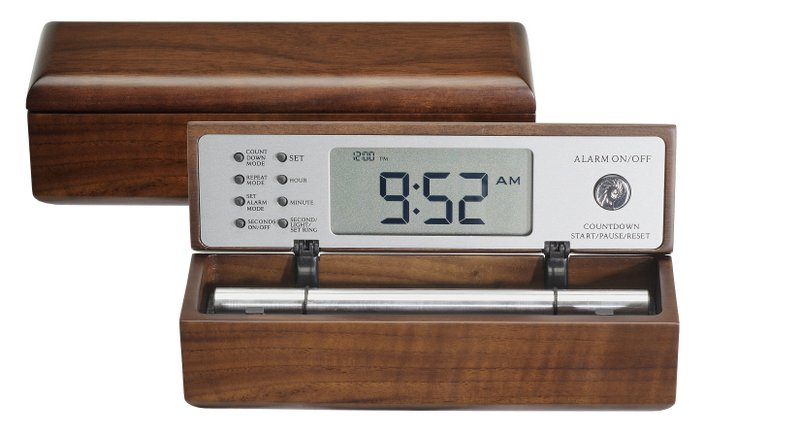 Gentle Chime Alarm Clock for a Progressive Awakening Now & Zen – The Zen Alarm Clock Store
1638 Pearl Street
Boulder, CO 80302
(800) 779-6383
Posted in Bamboo Chime Clocks, Chime Alarm Clocks, Dreams, sleep, Sleep Habits
 Why We Sleep Why We Sleep?
Sleep may really be–A series of repeated cycles of pruning and strengthening of neural connections that enables you to learn new tricks without forgetting old ones. Of course, none of that explains why you have to be unconscious for all the pruning and strengthening to occur. Maybe it’s just easier to be asleep than awake while the work is going on. “When you fall asleep, it’s like you’re leaving your house and the workmen come in to renovate,” suggests Terry Sejnowski, a computational neurobiologist at the Salk Institute in La Jolla, Calif. “You don’t want to live in the house while the construction’s going on because it’s a mess.”
It all sounds plausible enough, but that doesn’t mean everyone is convinced. “It may not sound exciting, but I think sleep is essentially for rest,” says Robert Vertes, a neuroscientist at Florida Atlantic University in Boca Raton. Vertes thinks most sleep scientists are overinterpreting their data because they find it so hard to believe that our brains just need to shut down for eight hours or so every night. As for what’s being done during that time, the short answer, he says, is “We don’t know.”
Perhaps the brain just needs to restore itself. “We’ve all had the experience of going to bed with a problem, getting a good night’s sleep and waking up in the morning, and there’s a solution,” says Dr. Gregory Belenky, who recently retired as head of sleep research at the Walter Reed Army Institute of Research in Silver Spring, Md., and is now at Washington State University at Spokane. But instead of thinking that extra information processing is going on during sleep, he says it makes as much sense to suggest that depleted circuits are just being rejuvenated.
The brain, like the rest of the body, runs on glucose, Belenky explains. Using computerized scanners that provide images in real time, he and his colleagues have shown that the brain’s ability to use glucose drops off dramatically after being awake 24 hours, indicating a decrease in brain activity–despite the fact that there’s still plenty of glucose available. The biggest drops occur in exactly those areas of the cortex that anticipate and integrate emotion and reason. After 24 hours, however, the drop-off stabilizes. “But performance doesn’t level off,” Belenky notes. “It continues to tank.” Why? No one knows.
In addition to refueling the brain, sleep seems to detoxify it. Animals with a high metabolic rate, like field mice and bats, use a lot of calories and generate a lot of destructive molecules called free radicals. “The brain is particularly susceptible to this because neurons, by and large, don’t regenerate,” says Jerome Siegel, a neuroscientist at UCLA and the Veterans Affairs Medical Center in Los Angeles. Maybe sleep provides necessary downtime so that the brain can deal with all those free radicals.
One of the ultimate Zen like experiences is waking-up from a great slumber refreshed and energized. Your mind and body are harmoniously one, both alert and focused. Having a refreshed mind and body are two keys to a natural and Zen lifestyle. Waking up in the morning should not be a loud and abrupt awakening, but rather it should be a peaceful positive experience. The right natural alarm clock can transition your deep and tranquil sleep into a serene start to consciousness. Imagine a long-resonating Tibetan bell-like chime waking you up to a beautiful morning experience.
The right alarm clock can be the most beneficial investment for you. With our Now & Zen natural alarm clock you are awakened more gradually and thus more naturally. Now & Zen is focused on creating a naturalistic lifestyle, and our clocks are an example of our philosophy.
adapted from Time.com by Christine Gorman
 Gradual Chime Clocks for a Progressive Awakening Now & Zen – The Gradual Chime Alarm Clock Store
1638 Pearl Street
Boulder, CO 80302
(800) 779-6383
Posted in Bamboo Chime Clocks, Now & Zen Alarm Clocks, sleep, Sleep Habits
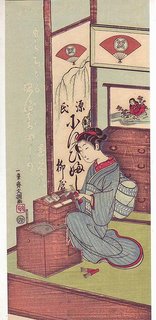 the more you sleep, the longer you live... It’s done in bed, it feels great and most Americans don’t get enough of it. It’s sleep, of course, the most undervalued contributor to optimum health and performance.
Did you know that sleep had anything to do with success in sticking to a diet? Get to know leptin and ghrelin. They sound like a Hungarian comedy act, but they are hormones that regulate appetite. Ghrelin is produced in the stomach and signals the brain when it’s time to eat. Leptin is secreted by adipose tissue (i.e., fat) and has the reverse effect, telling your brain when you are full. Chronic lack of sleep increases ghrelin and decreases leptin, leading you to feel hungry when you don’t really need to eat and to keep eating after you have gotten the calories you need.
Hitting the weights at the gym? Good sleep will bring you the results you want more quickly. The body repairs itself, including rebuilding your sore biceps, during the deepest phase of sleep. That’s why a good night’s sleep will not only make your workouts more productive but will also boost your immune system in general.
Despite these and other benefits, including greater mental alertness, improved concentration, better mood – even lower risk of car accidents – sleep remains underrated when it comes to health promotion. Maybe people can’t believe that something as mundane as consistently getting seven or eight hours of sleep a night can have such a positive impact on their health. Or maybe, in a culture of double cappuccinos and Ambien, sleep deprivation goes unrecognized in the first place.
If you get stuck in a period of weeks or even months where sleep is hard to come by (e.g., new baby, a big work deadline), pay off your sleep debt with extra sleep as soon as you can and you should suffer no long-term ill effects. But don’t make sleep deprivation a lifelong habit. A study of almost 7,000 Alameda County residents, over a nine-year period, found that people who routinely slept six or fewer hours a night had about 70 percent higher risk of dying than did people of similar age who slept seven or eight hours a night.
 choose deep and tranquil sleep - get a soothing chime alarm clock There are many common sense ways to make it easier to get to sleep, including keeping to a consistent schedule and avoiding big meals, caffeine and intense exercise just before bed. A full list of strategies is available from the National Institutes of Health at www.nhlbi. nih.gov/health/public/sleep/healthy sleepfs.pdf.
The Institute’s strategies for better sleep are useful, but they work only if you make sleep a priority, which many people in the compulsively busy Bay Area do not. If you think you don’t have time to sleep enough, remember that survey research shows that most people grossly underestimate how much time gets away from them in the evenings when they are idly surfing the Net or half-watching TV. If you feel tired, turn off the machines and go to bed. And if you believe you absolutely must see the next episode of “Big Brother” or a rerun of “Gilligan’s Island,” remember that TiVo and VCRs were invented so that we can watch such programs later, when we are rested enough to appreciate their nuanced messages and enduring contributions to our culture.
adapted from SFgate.com, by Dr. Keith Humphreys
One of the ultimate Zen like experiences is waking-up from a great slumber refreshed and energized. Your mind and body are harmoniously one, both alert and focused. Having a refreshed mind and body are two keys to a natural and Zen lifestyle. Waking up in the morning should not be a loud and abrupt awakening, but rather it should be a peaceful positive experience. The right natural alarm clock can transition your deep and tranquil sleep into a serene start to consciousness. Imagine a long-resonating Tibetan bell-like chime waking you up to a beautiful morning experience.
The right alarm clock can be the most beneficial investment for you. With our Now & Zen natural alarm clock you are awakened more gradually and thus more naturally. Now & Zen is focused on creating a naturalistic lifestyle, and our clocks are an example of our philosophy.
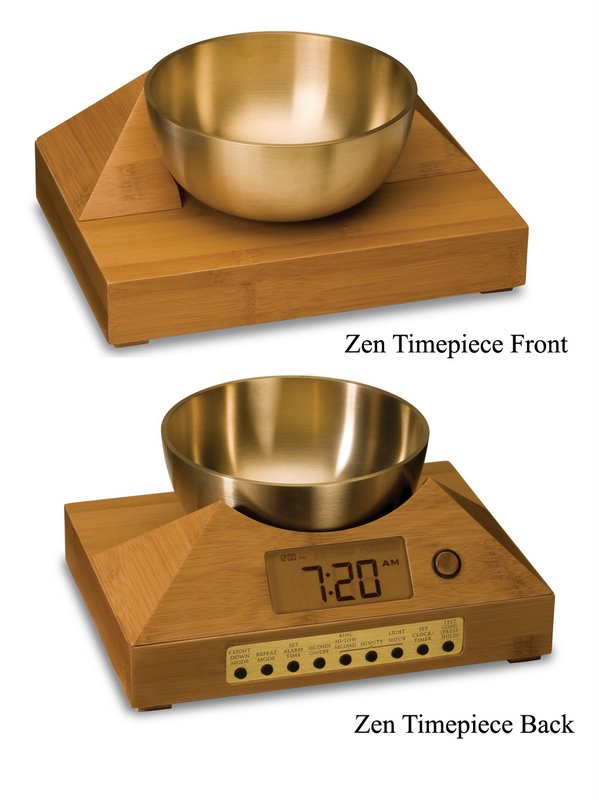 Choose the Gentle Chime Alarm Clock Now & Zen – The Gentle Chime Alarm Clock Store
1638 Pearl Street
Boulder, CO 80302
(800) 779-6383
Posted in Bamboo Chime Clocks, sleep, Sleep Habits, Zen Timers
 Warm winter sun “Imagine yourself outside on a beautiful Saturday afternoon, just in the flow, enjoying life. Suddenly the sun disappears behind a cloud that you didn’t know was there. It’s dark now, and you feel off kilter, sad.”
That’s how LeNeva Spires, who works as an executive assistant at a university in Portland, Oregon, describes the seasonal affective disorder (SAD) that affects her every autumn.
Though classified as a type of depression, “it feels more like something is missing, like things are not quite right,” says Spires.
It’s precisely brightness (or rather, the lack of it) that triggers this mood disorder, one of few health problems tied to a season. SAD primarily affects people who live in northern latitudes (above San Francisco and Washington, D.C.), and more women than men. It often begins in September or October, as the days shorten, and lingers until spring.
SAD tends to respond readily to the very thing we’re missing in the winter months: light. Learn how to get more of it as well as discover the best foods, exercise, supplements, and herbs to create your action plan for a brighter, happier winter.
1. Let There Be Light
For seasonal depression and the winter blahs, “the treatment of choice is light,” says psychiatrist Alfred Lewy. How do you get that light? You could move closer to the equator, where the sun rises and sets at a more consistent time all year long. Or, if your family and work life allow it, you could change your sleep schedule during the winter so you wake up a half-hour after sunrise (check your local paper to find out when the sun rises), and then go immediately outside.
But for most of us, the easiest option is to purchase a light box outfitted with special bulbs that mimic the brightness of the morning sun. Light therapy works by getting our sleep-wake cycle to synchronize with an electric-powered “sun,” thereby resetting our circadian clock. We tend to feel our best when we wake with the dawn, and the light box essentially helps you make your own dawn.
Light-Box Lowdown
Available online and at specialty stores (starting at about $160), light boxes are safe to use at home, whether or not you have an official diagnosis of SAD. Lewy recommends placing the light box at a 45-degree angle to you, from either the side or above, and starting with a morning dose of light: about 30 minutes, taken between 6 a.m. and 8 a.m. Some people may need more time — 45 minutes, or even up to two hours — but once they feel an improvement in their mood, they can reduce the sessions to 30 minutes.
The light receptors that help rest our circadian clocks reside in our eyes, so keep your eyes open during light treatment. In fact, Lewy suggests glancing sideways at the lightbulbs once or twice every minute (something you should never do with the real sun).
A small number of SAD sufferers respond best to early-evening light treatments. After a week or two of morning treatment, if you notice no improvement even with two-hour doses, try the evening sessions instead, suggests Lewy. People usually begin to feel better within a few days but should keep up the treatments daily, ideally from the onset of symptoms (usually in September or October) through at least March.
 bring on the night 2. Bring On the Night
You need a good night’s sleep in order to mitigate winter depression — and by “good,” Emmons means sleeping for eight or nine hours a night — but not more. Keep bedtime and wake-up time consistent, too; Emmons suggests going to bed between 10 and 11 p.m. and rising between 6 and 7 a.m.
Melatonin Matters
While light-box therapy remains the primary remedy for synchronizing your sleep patterns, supplementing with melatonin (the “darkness” neurotransmitter) may help, too. The brain’s melatonin levels rise to their highest level at night, and people normally start secreting the hormone a few hours before bedtime, to prime the body for sleep.
Like light therapy in the morning, taking melatonin supplements in the afternoon can help shift the circadian clock. In fact, Lewy often prescribes both morning light and 0.3 mg to 0.5 mg of melatonin in the afternoon for best results in resyncing the circadian processes. Since melatonin can make some people sleepy, avoid driving as you figure out the best dosage. You’ll find melatonin tablets at natural-foods stores.
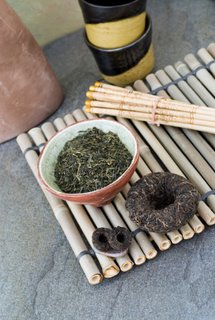 eat well 3. Eat to Feel Good
What we eat can affect our brain chemistry and our mood. To combat SAD, Emmons recommends focusing on foods that increase and stabilize levels of serotonin, a mood-improving hormone that tends to decrease in the winter. These foods include choices rich in tryptophan, a building block of serotonin.
We often crave high-carbohydrate comfort foods in winter, but it’s wise to resist the urge, he says. As he explains it, indulging in refined carbs, such as white bread and white rice, may indeed offer an initial feel-good spike in serotonin levels. But, as with a sugar rush, refined carbs end up depleting our serotonin levels soon after.
Instead, eat a variety of complex carbohydrates, such as barley, brown rice, oats, and other whole grains, and include a small amount of lean protein, ideally a high-tryptophan protein (turkey, cheese, eggs) at each meal or snack. Also include leafy green vegetables, such as kale and bok choy, which provide mood-supporting B vitamins and minerals that help convert tryptophan into serotonin.
4. Move and Stretch
“Exercise helps [all types of depression] for many reasons,” says Emmons. It boosts serotonin levels in the brain; it improves circulation, which gets more blood and nutrients to the brain; it increases energy and metabolism, even at the cellular level; and it improves glucose regulation, which also affects energy levels.
For those taking antidepressant medication, exercise helps improve the effectiveness of the drug, likely by improving circulation. More of the medicine gets to the brain, where it’s needed, and the body metabolizes the drug more easily, which reduces side effects.
The best news about SAD and exercise, says Emmons, is that you don’t have to take your workout to the extreme. Mild aerobic exercise for 30 minutes can usually lighten your mood. If it’s not too cold, walking outdoors is a great option. At the gym, try the stationary bike or treadmill for a half-hour every day.
5. Supplement Smartly
Several dietary supplements can help fill in any nutritional gaps and in turn may lift your mood. Emmons says his clients have had success with the following four:
Vitamin D
Deficiency in this vitamin is extremely common and may contribute to both ordinary and seasonal depression (along with other illnesses). While light boxes substitute for the sun in certain ways, they don’t provide this critical nutrient (which is more of a hormone than a vitamin). In the winter, a vitamin D supplement can help regulate your mood.
Dosage: 2,000 IU of vitamin D3 daily
Multivitamin
A good one includes plenty of B vitamins, as well as key minerals such as selenium (which helps support mood) and magnesium (which reduces anxiety and muscle tension).
Dosage: 1 daily
B-Vitamin Complex
These assist the brain in producing neurotransmitters such as serotonin and norepinephrine.
Dosage: One B-50 supplement daily (along with the multivitamin)
Omega-3-Rich Fish Oil
Studies suggest that omega-3 fatty acids may help prevent and ease depression and other mood disorders. Flax makes a good substitute for strict vegetarians.
Dosage: 1,000 mg of fish oil in capsule form twice daily, or 1 tablespoon of flax oil twice a day
6. Take It Outside
 go outside to cheer up Spending time outdoors helps us reconnect with nature, says Emmons, thus healing a rift that seems to lie at the heart of seasonal depression. If you combine a serotonin-boosting exercise with your outdoor time — like a brisk walk at a local park or an afternoon of cross-country skiing — you’re combating the winter blues on two fronts.
During the summer, take advantage of the sunlight by spending 15 to 20 minutes a day in the sun without sunscreen (unless you’re at risk of skin cancer). This will help build your vitamin D levels for next year.
7. Try Healing Herbs
Certain medicinal plants ease the winter blues, says Margi Flint, who runs the Earthson Herbals school in Marblehead, Massachusetts.
Uplifting Tea
For a mild, mood-boosting infusion, simmer 1 ounce oatstraw in 1 quart of water for 40 to 60 minutes. Remove from heat, add 2 tablespoons of dried chamomile and 2 tablespoons of dried lemon balm; cover and steep for 15 minutes. Strain and drink several cups daily.
Aromatherapy
Since the smell of any citrus uplifts the spirit, add a total of 10 drops of any combination of lemon, lime, and orange essential oils to each ounce of lotion or massage oil. Use daily, or use these oils in a diffuser.
Daily Tonic
Holy basil, ashwaganda, and gotu dola — from India’s traditional system of medicine, Ayurveda — help ease depression. Flint suggests using the powdered form; add a 1/4 teaspoon of each to oatmeal or applesauce.
8. Don’t Go It Alone
As with any form of depression, working with a mental-health professional for SAD can be beneficial. If you experience suicidal thoughts or other serious symptoms, seek help immediately.
One of the ultimate Zen like experiences is waking-up from a great slumber refreshed and energized. Your mind and body are harmoniously one, both alert and focused. Having a refreshed mind and body are two keys to a natural and Zen lifestyle. Waking up in the morning should not be a loud and abrupt awakening, but rather it should be a peaceful positive experience. The right natural alarm clock can transition your deep and tranquil sleep into a serene start to consciousness. Imagine a long-resonating Tibetan bell-like chime waking you up to a beautiful morning experience.
The right alarm clock can be the most beneficial investment for you. With our Now & Zen natural alarm clock you are awakened more gradually and thus more naturally. Now & Zen is focused on creating a naturalistic lifestyle, and our clocks are an example of our philosophy.
adapted from Body + Soul, January/February 2009
 Bamboo Alarm Clocks & Meditation Timers
Now & Zen – Gradual Chime Alarm Clock Store
1638 Pearl Street
Boulder, CO 80302
(800) 779-6383
Posted in Goodness, Insomnia, intention, sleep, Sleep Habits, Well-being, Zen Timers
« Previous Entries
Next Page »
|
|
|
|